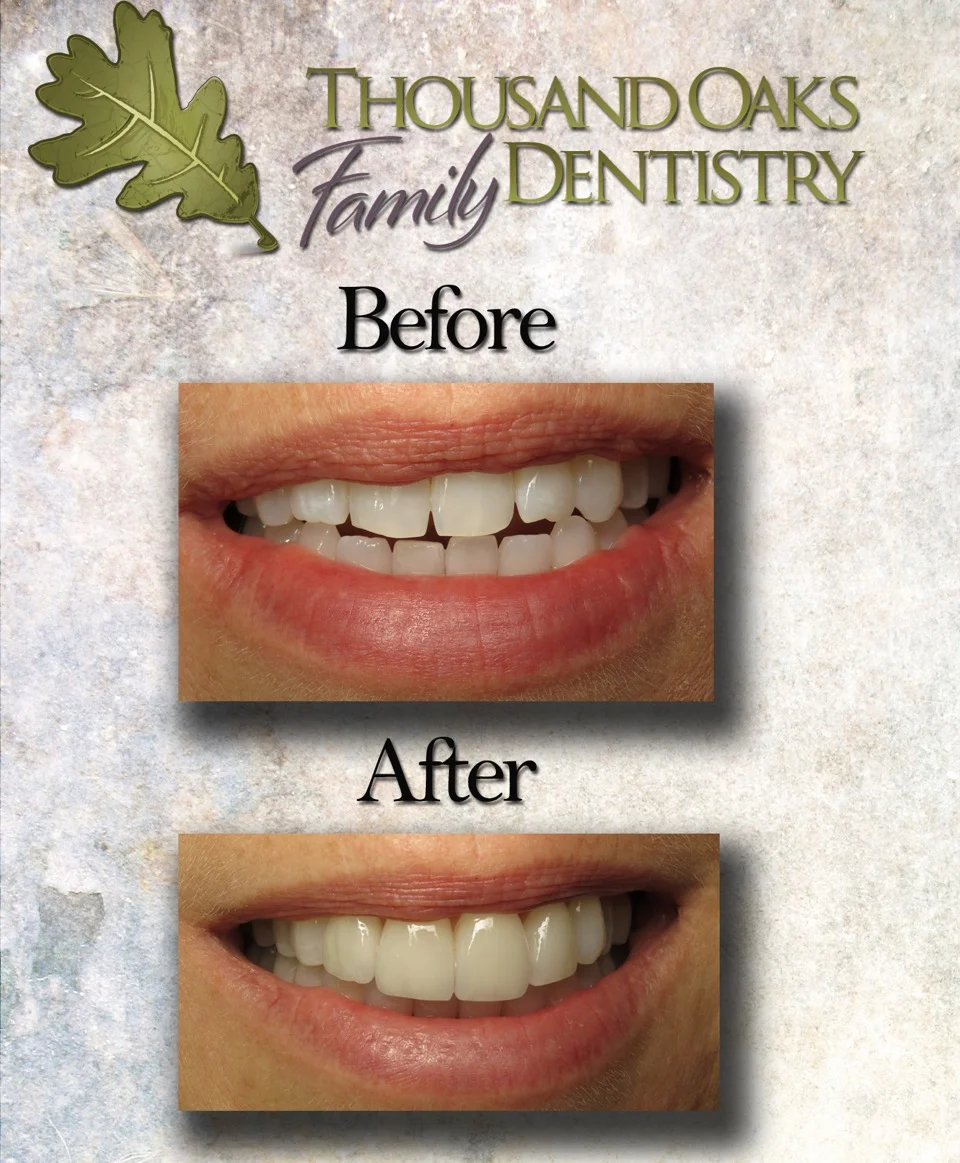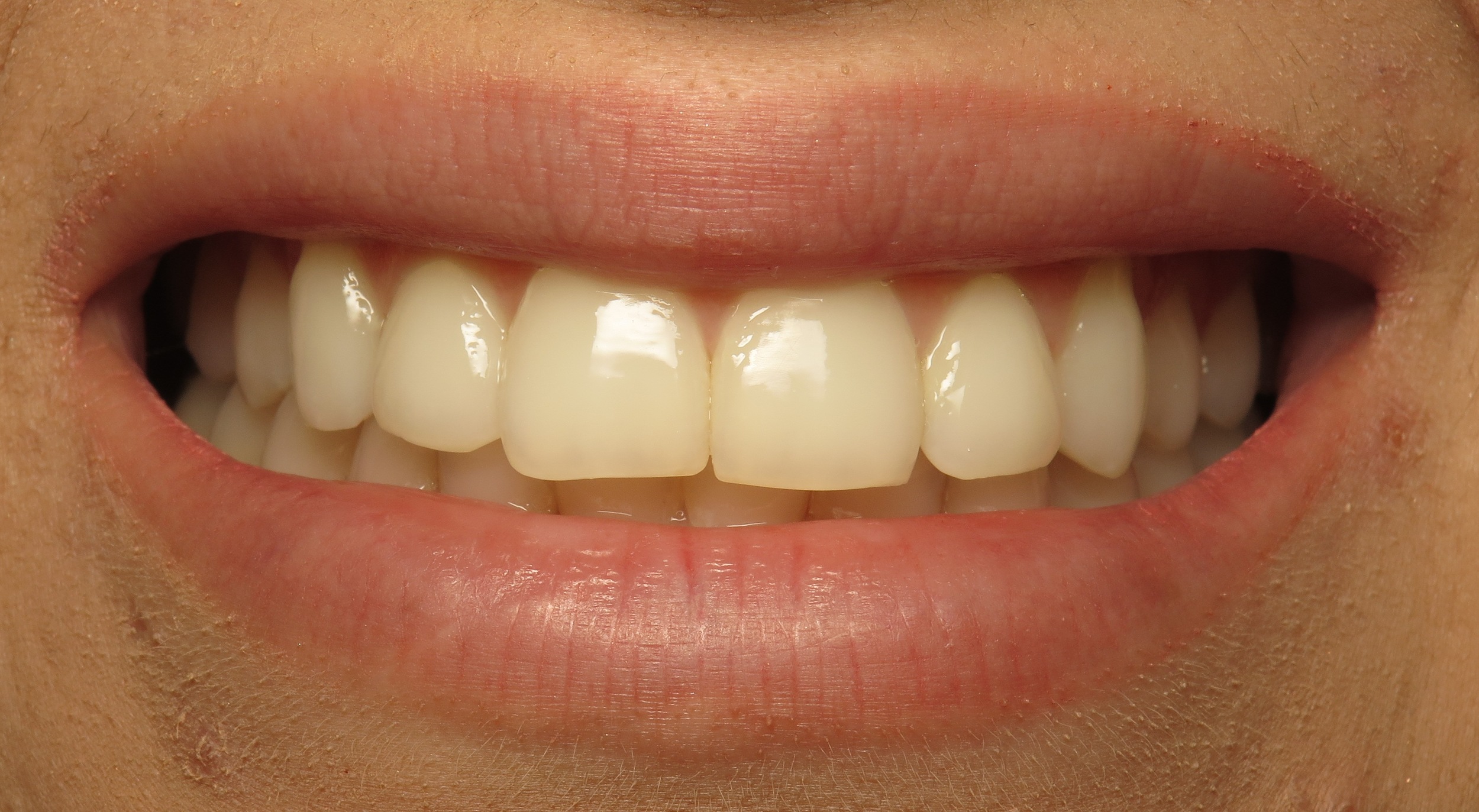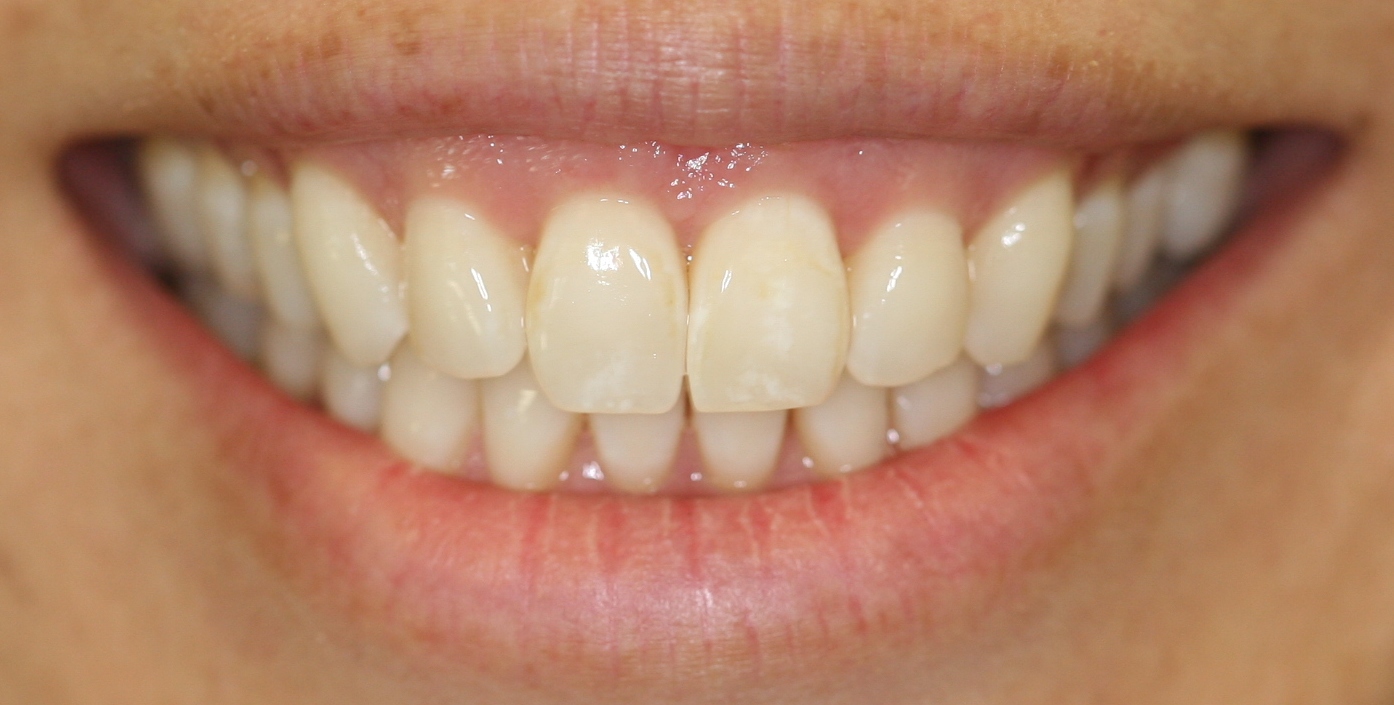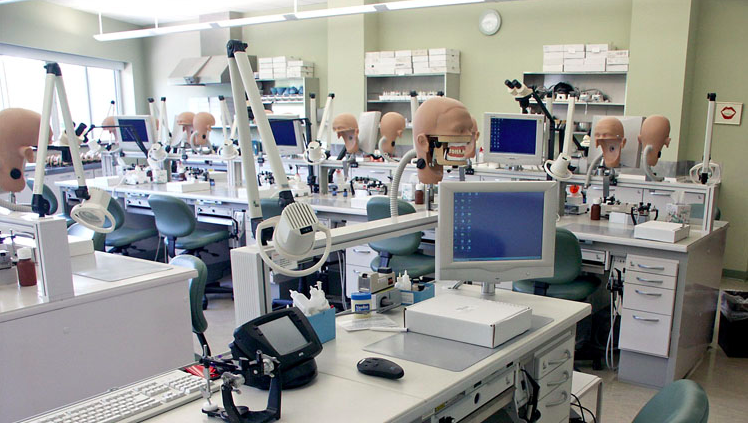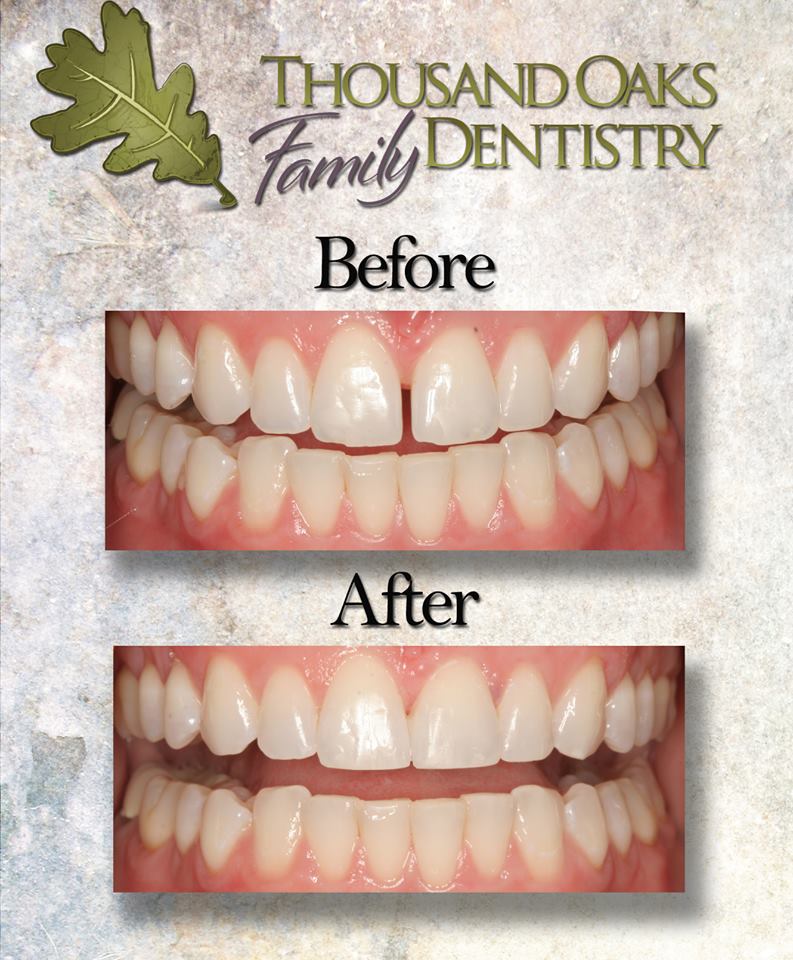In many cases, veneers provide a drastic change to the the teeth and smile appearance. This patient was no exception, where cosmetic veneers were used in conjunction with a full Invisalign treatment. By removing a small amount of tooth structure, Dr. Hong created room for a set of lithium disilicate veneers to be placed on the four front incisors. These veneers corrected for irregularities in tooth shape, size and dimension. They also allowed her to develop a more robust and youthful profile by adding contour to the front of the teeth. The overall effect is instantly noticeable and we are very happy with the results! If you would like to know more about veneers or would like to schedule a consultation with our office, please give us a call!
Viewing entries tagged
esthetic dentistry
For many patients, cosmetic veneers are a great way to transform their smile with a short turnaround time. This patient is a grandmother who always wanted to close the gaps in her front teeth. Using veneers, we will both close the gaps and create a beautiful and natural looking smile. We just finished the first part of her treatment, where we prepared her four front teeth, took impressions and made the temporary veneers. She will return in about two weeks to cement the final product!
Before
Before veneers, this patient's teeth had large spacings and were not completely symmetrical.
After
Here is the same patient with her temporary veneers on. You can really see how this procedure will create a more esthetic smile!
The "after" photo shows our patient in acrylic temporary veneers. They are created immediately following the preparation to hold space for the permanent restoration. Right now, our dental lab is working on the permanent veneers, making sure they have the right color, shape and opacity to match the rest of her teeth. We are eagerly awaiting the final product and will post as soon as we deliver it!
Take a look at one of our recent smile transformations! This patient came to our office with concerns about the esthetics of their anterior incisors. Wear to the incisal edges (biting surfaces) had created a "flat and sharp" appearance that takes away from the naturally contoured look teeth typically have. By using zirconia veneers, our office restored dimension and shape to the incisal edges and facial profiles of the lateral and central incisors. This allowed us to give the teeth a more youthful look and create a universally lighter shade. If you would like to know more about this process or other esthetic services we offer, please contact our office!
Last month, we posted a blog article on The Golden Proportion, a set of dimensions based on ideal proportions found in nature. When it comes to the smile, these proportions are only one piece of the aesthetic puzzle. The position of the lips framing the teeth, the angulation of the teeth, and the location of the dental midline are all examples of factors that influence our interpretation of a pleasing smile. However, the golden proportion is an interesting feature to study, as it is so deeply rooted in mathematics. To better explain how the golden proportion helps define facial esthetics, we assembled a few real-life cases for you to examine!
Case 1
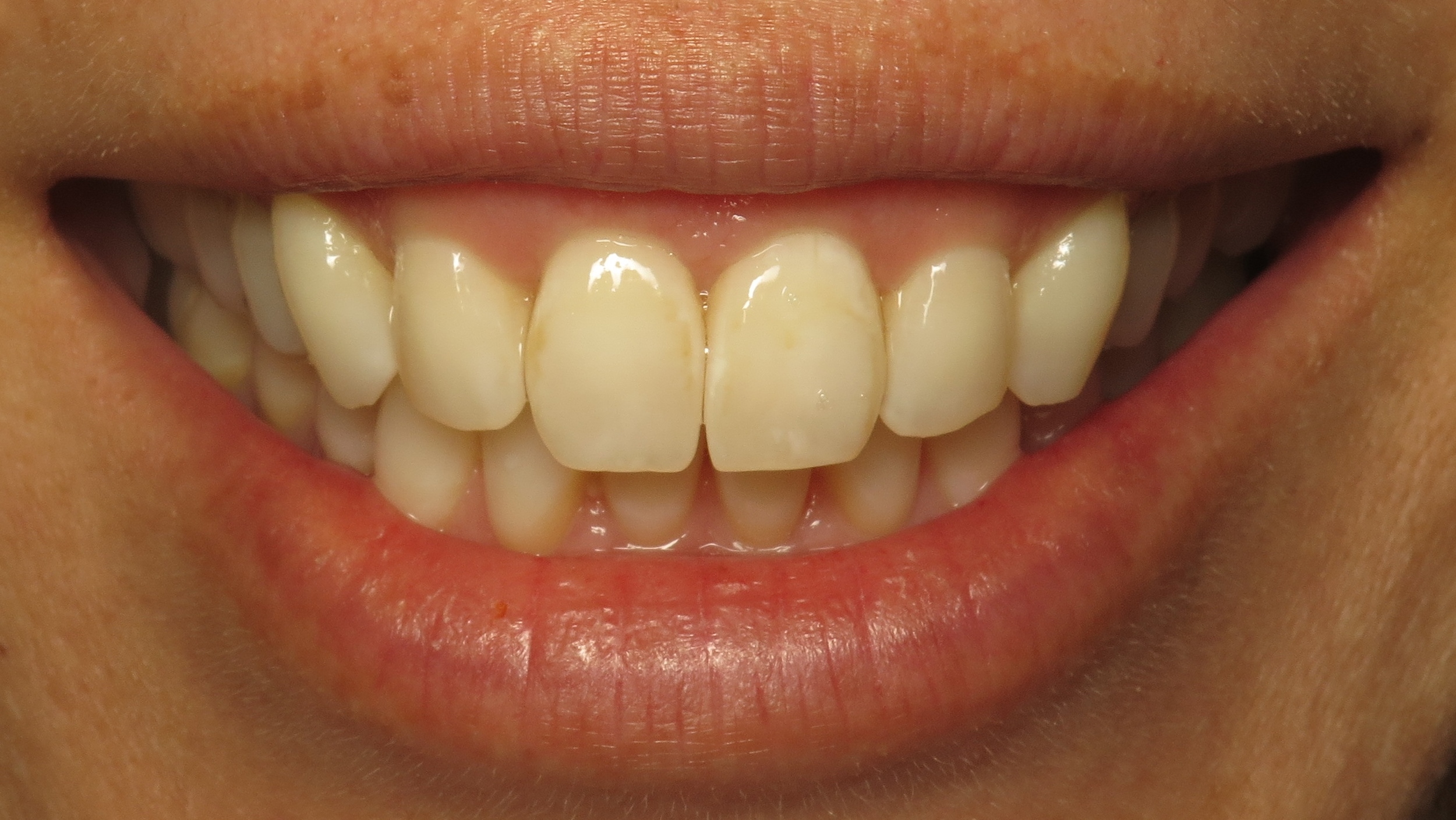


Central tooth width to length ratio: 74% (ideal is 75-80%)
Golden proportion ideal measurements based on a 2D picture:
- Central 1.618
- Lateral 1
- Canine 0.168
Golden proportion ideal measurements, assuming the central is ideal width:
- Central 7.4
- Lateral 4.6
- Canine 2.8
Comments:
Case 1 has centrals that follow an ideal width to length ratio at 74%. In evaluating the golden proportion, the laterals and canines are wider than ideal. The frame of the lips is much wider than in Case 2 or 3, so the gum tissue above the gum/tooth margin is very visible.
Case 2
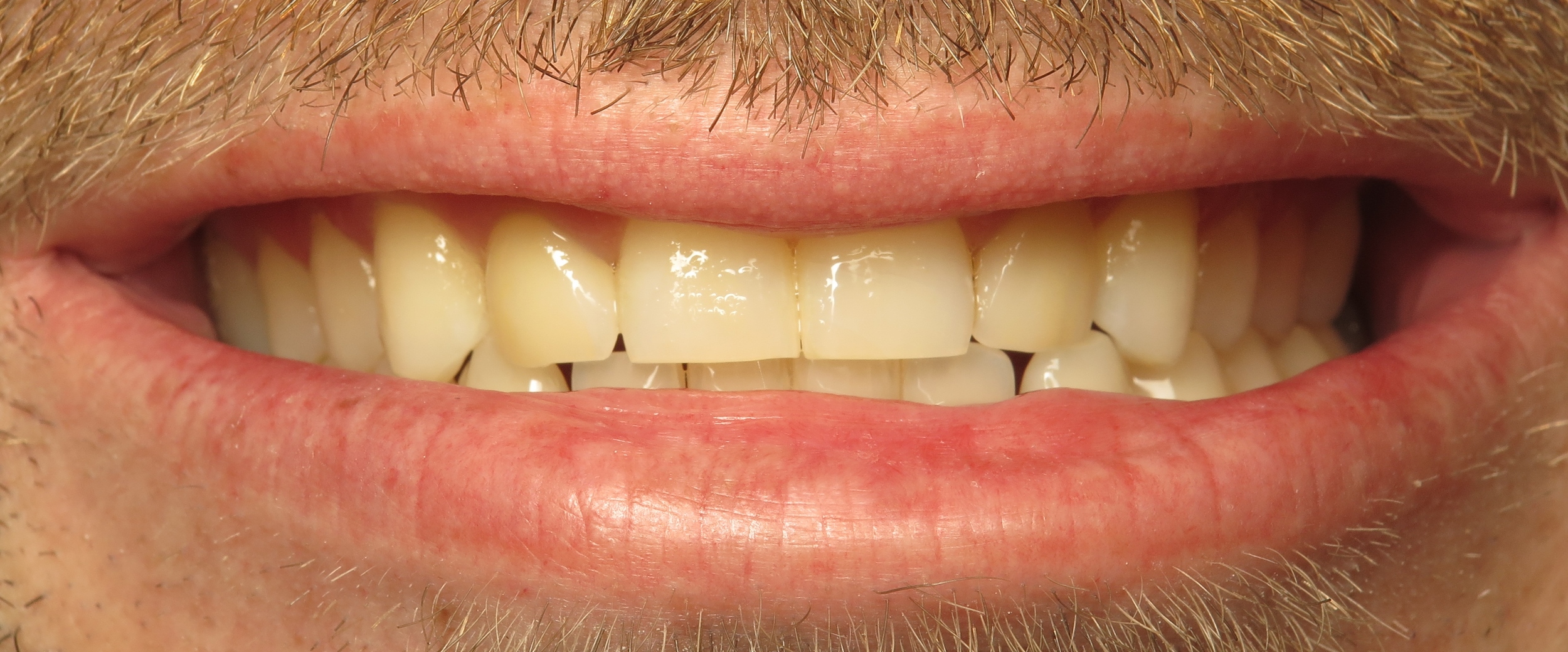


Central tooth width to length ratio: 96% (ideal is 75-80%)
Golden proportion ideal measurements based on a 2D:
- Central 1.618
- Lateral 1
- Canine 0.168
Golden proportion ideal measurements, assuming the central is ideal width would be
- Central 8
- Lateral 4.9
- Canine 3.0
Comments:
Case 2 has centrals that are nearly 1:1 in the width to length ratio and have a square appearance. It appears that the centrals have some wear on the biting edge and that they could stand to be 1-2 mm longer. The laterals and canines are slightly wider than the golden proportion measurement. The patient's lips frame the overall smile so that hardly any of the biting edge or gum/tooth margin of the teeth show. Thus, the aesthetic discrepancies are less noticeable.
Case3
Central tooth width to length ration: 90% (ideal is 75-80%)
Golden proportion ideal measurements based on a 2D picture:
- Central 1.618
- Lateral 1
- Canine 0.168
Golden proportion ideal measurements, assuming central is ideal width:
- Central 9
- Lateral 5.6
- Canine 3.5
Comments:
In reviewing the three cases presented here, Case 3 has nearly exact golden proportions. The central tooth width to length ratio is slightly greater than ideal at 90%, but the upper lip covers enough of the gum/tooth margin of the centrals that this ratio isn't as relevant in evaluating aesthetics. Also, the upper and lower midlines are slightly off center from one another, but the upper central midline is perpendicular to the floor of the mouth and centered with the patient's nose. Thus, the midline is aesthetic even though the upper and lower midlines don't match each other.
Have you ever wondered why it is so easy to spot a perfect smile? It’s something almost all of us can do subconsciously. Beyond straight white teeth, there is something that just seems to stand out on someone with a “Hollywood smile.” Believe it or not, mathematics and proportions dictate the esthetics of our teeth and facial characteristics. By following a few basic ratios and the golden proportion, it is easy to see how a great smile comes together!
When we smile, our maxillary (upper jaw) anterior teeth will show the most. Our two central incisors are flanked by slightly smaller lateral incisors and then by the canines. The premolars and molars behind the canines will show as well, which contributes to the “width” of the smile. In an ideal situation, the line between the two front teeth should run perfectly parallel to a line drawn between the eyes or ears. This measurement is of particular concern in patients with head and neck injuries or asymmetrical faces. In addition, the two central incisors should be about 80% as wide as they are is tall. That is, if the tooth is 10mm tall it should be nearly 8mm wide to look the most natural.
The most important principle to follow in facial esthetics is something called the golden proportion. This principle dictates the relative widths of the anterior teeth. Here, the lateral incisors are used as a reference factor of 1. The central incisors should be 1.618 times the size of the laterals, while the canines should only take up about .618 of the space. These very specific numbers can separate artificial “chicklet” looking teeth from a well rounded and robust natural smile. When performing cosmetic procedures such as crowns and bonding, we always work our hardest to preserve and develop these dimensions.
These ideas and principles dictate how our office works towards creating beautiful and esthetically pleasing smiles. Most people are not born with these ideal dimensions and still have beautiful faces. What these numbers do, however, is establish a guideline for how we approach crowns, dentures, implants and restorations to the anterior teeth. Don’t measure your own smile and become disappointed! These numbers do not take into account a number of other factors that can alter your facial appearance. Everyone has a unique smile and deserves a unique treatment!
At Thousand Oaks Family dentistry, we offer a wide range of services that can create mild to dramatic changes to your smile. As with any procedure, we can only decide what treatment is appropriate for you with a full consultation and exam. If you would like to learn more about facial esthetics and cosmetic dentistry, please contact our office!
As you likely already knew, one of the cornerstones of modern medical education is the idea of being a “lifelong learner.” Dentists, physicians, hygienists and nurses all have to meet yearly “continuing education” requirements to hold a valid license and continue providing care. At Thousand Oaks Family Dentistry, we pride ourselves in treating our patients with the most up to date and complete dental knowledge. With this principle in mind, we are proud to announce that Dr. Kari Ann Hong recently completed training at the prestigious Pankey Institute in Miami, Florida.
The Pankey Institute offers world class teaching facilities and laboratories (pankey.org)
The Pankey Institute is a nonprofit organization that prides itself in offering unbiased and research proven dental courses. Their current curriculum spans the entire scope of practice, including esthetics, night guards, and functional shaping of dental restorations. The culmination of their educational program is the Core Diagnosis principle. Here, a series of facial measurements and proportions are used to make better decisions for cosmetic procedures such as orthodontics, crowns/veneers and periodontics. Tooth shape, gum height, and smile size all have a dramatic effect on how we perceive facial esthetics. This system collects all this data to define the safest and most efficient way to develop a beautiful and natural looking smile!
The Core Diagnosis system takes a unique and comprehensive look at facial esthetics.
Dr. Kari started her coursework with the Pankey Institute in 2007 and completed their most up-to-date coursework in October of 2014. She has been proud to utilize their unique and patient focused perspectives for effective dentistry. Beyond many continuing education courses, the Pankey program brings together cosmetics, prevention and patient safety- Ideals we strive for with everyone who visits our office.
If you have any further questions on why we chose the Pankey Institute or any other educational programs we use, please let us know. Our office is here to provide the absolute best service we can. We always strive to use techniques, ideas and products that keep our patients at their healthiest!
When having a crown or bridge placed, your ultimate goal is to have it look, feel and function like the natural tooth that was there before it. While this process is never “easy,” it becomes even more difficult when dealing with anterior (front of the mouth) teeth. For these complicated lab cases, we are proud to work with Opus One Dental Lab and it’s owner, Uri Yarovesky.
Uri standing with his many awards and honors.
Uri has over 40 years of experience in the dental field as a technician, lab owner and world recognized lecturer. He has made crowns and bridges for celebrities, heads of states and even as prosthetics for blockbuster movies. His credentials include countless awards from the most prestigious dental publications and institutions. Opus One Lab was designed as an extension of his years of experience- cutting edge techniques with a personal touch. In addition to the typical technologies and instruments you would find in most labs,this office houses a research facility used to develop and manufacture new ceramic technologies. For some of the services the lab offers, they are the only location in the entire world with this technology available.
Crowns on anterior teeth need to be a near identical match to the surrounding teeth. Small deviations in coloration, shape, size or translucency can translate to a product that looks “fake” or out of place. It takes careful examination and years of experience to deliver a perfect prosthesis that feels great. Opus One delivers this by offering customs shade matching appointments, where you meet with Uri one on one to design and perfect your dental crown. He and his team have a deep appreciation for dental restorations and can meet your desires on shade, feel and even age appropriateness.
We love working with Opus One because they are both a local business and a global leader in dental technology. Uri’s lab understands the importance of both esthetics and function in delivering a quality product. Their crowns and bridges fit and look great, which results in happier and more satisfied patients.
Often times, patients will be very satisfied with their oral esthetics aside from one feature. Thier teeth can be straight, white and well spaced, saving for a single tooth. In these cases, orthodontics may be impossible or unnecessary for purely esthetic results. Here, cosmetic bonding proves to be the most predictable and reliable treatment to a perfect smile.
In this case, bonding was added to compensate for a short lateral incisor (left of center).
Cosmetic bonding is one of the most underappreciated cosmetic procedures offered in dental offices. Using the same tooth colored material as fillings, we rebuild and recontour teeth to better fit and fill out your smile. This material is extremely durable, and can be used to lengthen, widen or "even out" the appearance of your front teeth. Our patients are always satisfied with the results, as the transition from natural tooth to filling material is virtually undetectable.
Here, bonding was used to close the gap between the patient's two front teeth.
Your appointment will begin with a short consultation on esthetics and a few photographs. We strive to match your expectations and desires before we start working in your mouth. Once a decision has been made on how and where to add bonding, we use high pressure air abrasion to temporarily roughen the tooth surface. This step is comparable to rubbing wood with coarse sandpaper before painting. After the tooth surface is prepared to accept composite, we add our bonding agents to the indicated area, followed by the tooth colored composite. Our composites come in a variety of shades and color, and can match practically any tooth shade. The material is added slowly, contoured to your tooth, and set solid via a high intensity curing light.
After we select an appropriate tooth color and light cure it, we begin shaping the material to resemble a completely natural tooth. The refinement process utilizes sanding discs, polishing points and a number of sensitive techniques. The results look and feel completely natural in your mouth.
However, there are limitations to cosmetic bonding. It can generally compensate for deficiencies in tooth structure, but cannot address size issues such as overcrowding. Additionally, once structure has to be built out over 3-4mm, bonding becomes a less reliable long term cosmetic solution. For these in-depth cases, we typically recommend more involved esthetic procedures. Finally, bonding can interfere with teeth whitening or whitening results. Since bonding material does not respond to hydrogen peroxide, it does not change shade proportional to your natural teeth. Hence, we recommend you complete a bleach treatment prior to performing esthetic bonding.
Many consider veneers, orthodontics and whitening as the standard of dental esthetics. However, we urge you to consider bonding to address your mild to moderate cosmetic dental concerns. The minimally invasive nature of these procedures makes them convenient and accessible to many patients. Feel free to call our office with any questions or concerns you have about the process, materials or results behind cosmetic bonding.
One of the hundreds of beautiful amalgam swaps we have performed at our office.
Amalgam fillings are a tested and proven dental material and have been in effective use for over 100 years. There are many aspects of these metal fillings that make them excellent candidates for tooth restoration; they are durable, easy to place and have many of the same physical properties as natural tooth structure. However, they are not perfect (there are no perfect materials in dentistry). Over time, amalgams can crack, “leak” or become surrounded with decay. Furthermore, they are not as esthetically pleasing as tooth colored materials and can tarnish from silver to black very quickly.
These are some of the compelling reasons that we remove amalgam fillings at Thousand Oaks Family Dentistry. While we recommend replacement for ALL compromised fillings (both metal and tooth colored), we only replace amalgams for esthetics upon patient request. Additionally, we do not recommend removing metal fillings over concerns of mercury exposure. The long term safety of amalgam fillings and their associated mercury content is well understood and documented. Additional information can be found at http://www.ada.org/en/member-center/oral-health-topics/amalgam or by calling our office.
The result of an amalgam replacement procedure. While amalgam fillings are easy to spot, composite fillings blend very well with natural tooth structure. However, this difference in esthetics does not necessarily make one type of filling functionally superior.
The removal process is a simple procedure that parallels how we place fillings on decayed teeth. We start by removing the existing amalgam from the tooth by carefully cutting it with a high-speed handpiece (“drill”). While amalgam fillings are very safe, there is a slightly elevated risk of mercury exposure upon their removal, as the material becomes loosened and aerosolized. To counteract this, we rely on two forms of suction and isolation to prevent any of the metal from being swallowed. Typically, we pair an Isolite suction/bite block with our high speed suction to gather any stray metal.
Once the amalgam is removed, we eliminate any decay under or around the filling and reshape the tooth to better accept the new composite. Once the tooth is “prepared,” we proceed by bonding and curing in tooth colored material. After it is set, we recontour the filling to the natural shape of your teeth and adjust so it feels natural in your mouth. The entire process takes under an hour, and can be considerably shorter depending on the size and shape of the existing amalgam.
If you have any questions, or would like more information on how and why we remove amalgam fillings, please call our office. We regularly remove amalgam fillings under a number of different scenarios, and would be more than happy to walk you through the process.



